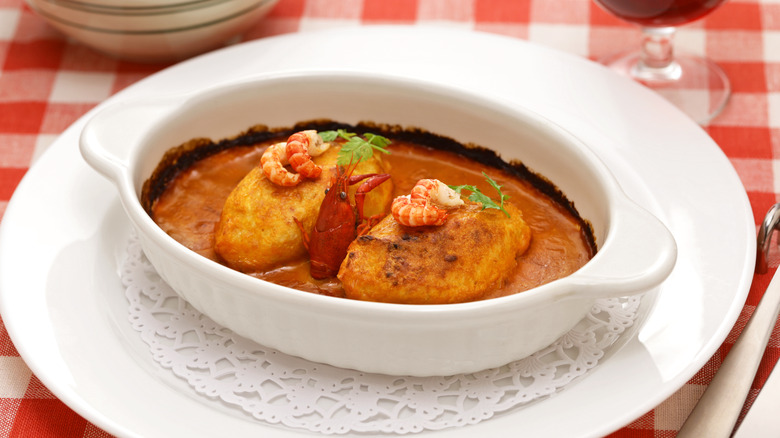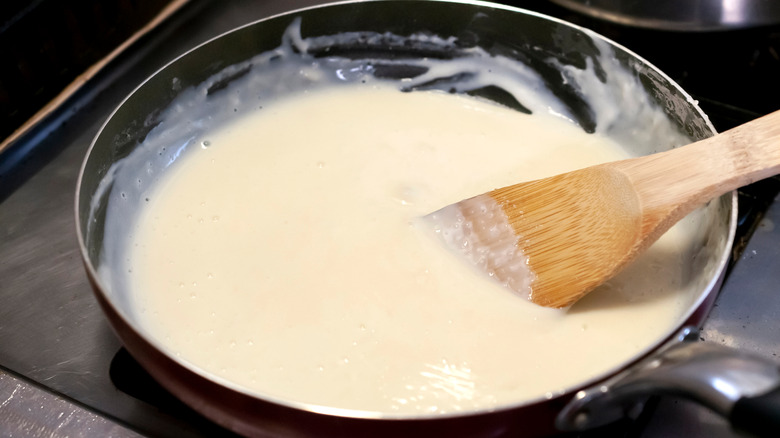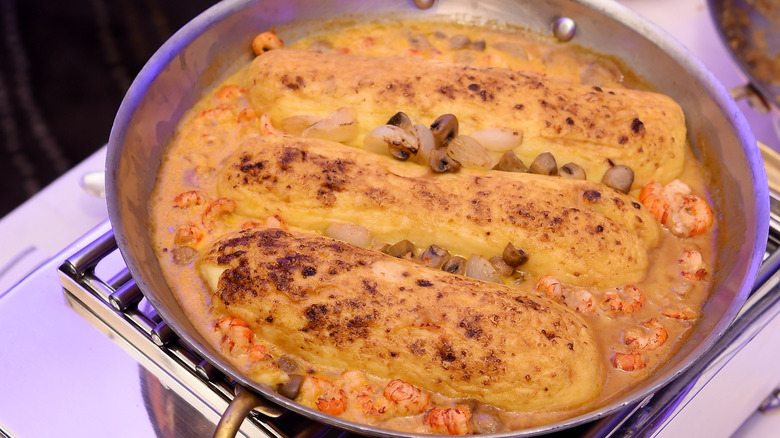The Difference Between Nantua Sauce And Béchamel
When it comes to elevating the flavors of a dish, sauces play a crucial role. Two classic French sauces, nantua and béchamel, have stood the test of time, continuing to enchant food enthusiasts around the world and play an important part in French cuisine. Though one would not exist without the other, each sauce possesses a unique identity and distinct purpose.
Béchamel, also known as white sauce, is a staple in French cuisine. It is a simple yet versatile sauce made from a roux that's combined with milk and infused with seasonings. Sauce Nantua, on the other hand, is a rich, creamy sauce hailing from the French town of the same name. Traditionally, it is made by combining béchamel with cream, crayfish butter, and, occasionally, crayfish tails, and the result is a decadent cream with a freshwater shellfish flavor.
In French gastronomy, sauces are taxonomized into mother sauces, of which béchamel is one, and Nantua could rightly be called a child sauce, being a derivative of the former. Béchamel, though used on its own, is often a canvas that can be customized with different herbs, spices, or even cheese, depending on the desired flavor profile. Sauce Nantua is one such customization, as the crayfish imparts a distinct flavor to béchamel, transforming it for uses when seafood notes are desired.
What is Béchamel and how is it used?
Béchamel serves as the cornerstone for countless classic dishes. Its creamy and smooth texture makes it an ideal base for various recipes, including gratins, lasagnas, and vegetable preparations. The rich but relatively neutral flavor of béchamel makes it adaptable to a wide range of ingredients that complement its flavor without overpowering it.
To create béchamel, butter is melted in a saucepan and an equal amount of flour is gradually whisked in. This forms a roux, which is cooked until it reaches a golden color. Next, warm milk is slowly incorporated into the roux while continuously whisking to ensure a smooth consistency. The sauce is then simmered until it thickens, and seasonings like nutmeg or white pepper can be added to taste. It can also be customized by adding piquant elements, such as mustard, to create a tangier sauce or flavored with herbs like thyme or bay leaves for a more aromatic profile.
What is sauce Nantua and how is it used?
Sauce Nantua shines when paired with seafood dishes, for which the town of Nantua, with its gem of a glacial lake, is renowned. The star of this sauce is the crayfish (aka crawfish), which lends not just a unique taste but a vibrant orange hue to the finished product. At its most basic, sauce Nantua is a velvety base of béchamel mixed with crayfish butter and finished with a touch of cream and, optionally, crayfish tails. More complex preparations might feature white wine, Cognac, tomato paste, mirepoix, and other ingredients to further deepen the flavor.
The rich and savory flavors of sauce Nantua provide a delightful contrast to seafood's natural sweetness. It adds a decadent touch to classic dishes like the iconic Nantuan dish, Quenelles de Brochet. This dish uses another regional seafood favorite, pike, to create dumplings of fish forcemeat that are poached before being topped with sauce Nantua and browned under the broiler.
While sauce Nantua owes its very existence to béchamel, they fulfill very different culinary needs. Béchamel's scope is vast, and it can be used as a creamy luxury on its own or transformed into a number of other sauces, such as Mousseline, Soubise, and Mornay. Sauce Nantua is more pointed, but still lends itself to culinary adventure. Try it over a simple filet of broiled mild fish or served with crayfish's ocean-going cousin, lobster.


